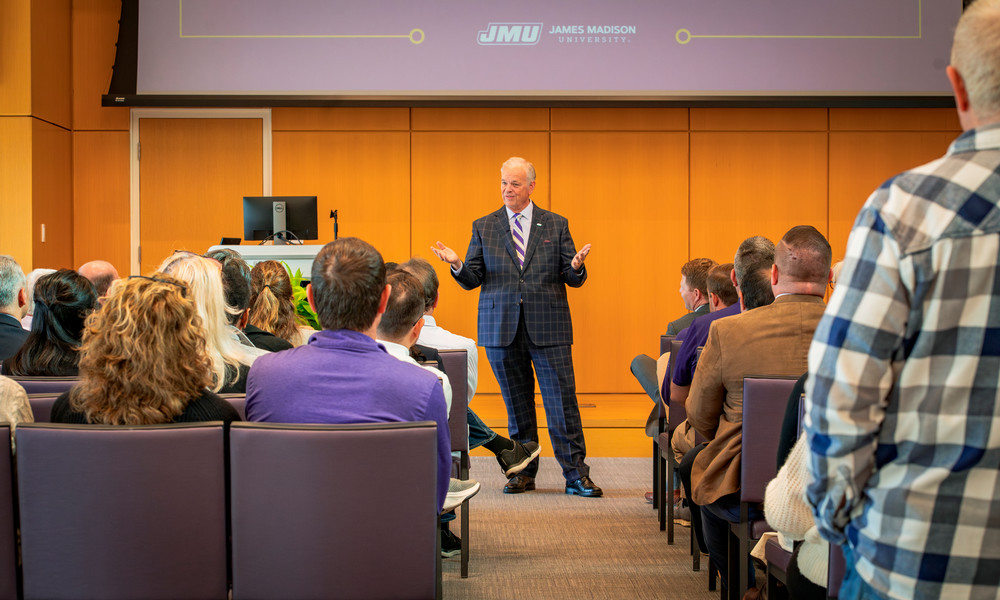President Jim addresses CoB faculty and staff
News
SUMMARY: As JMU’s strategic plan comes under review, President James C. Schmidt is seeking all the input he can to inform the future.
The university community welcomed President James C. Schmidt in July, and since then he has been traveling across the campus, the Commonwealth, and soon, the country in an effort to get to know students, alumni, parents, donors and friends. As a part of his Presidential Tour, one key focus is relationship-building, both within the university and with external partners, to foster ideas for the future of James Madison University. As JMU’s strategic plan comes under review, now is the perfect time for “President Jim” to hone in on the university’s strengths and further develop his own vision and personal strategic priorities.
As a part of his efforts to familiarize himself with the university and garner input for the future, President Jim was the featured speaker at the College of Business’s Fall Town Hall, which took place October 10. Prior to the meeting, Dean Michael E. Busing polled faculty and staff for topics and issues they would like to discuss with the President, and based on responses, three CoB-specific questions were developed.
Faculty Capacity and Academic Quality Amid Enrollment Growth
With JMU’s enrollment rising—particularly in the College of Business—how will the administration ensure sufficient full-time faculty hiring, maintain academic rigor, and manage class sizes to preserve educational quality?
President Jim acknowledged the challenge and emphasized the importance of intentional planning. “Growth is an easier problem to solve as long as it’s managed,” he said. “We’ve got to have great faculty and staff. You’ve got to have manageable class sizes. And you’ve got to figure out how to make sure the resources go around.”
He also noted that boosting out-of-state enrollment could serve as a strategic advantage to increase revenue and diversify classroom perspectives. “Somebody who grew up in New York City participating in a class is going to have a different perspective than somebody who grew up in rural Virginia,” he said.
Strategic Vision for Research, Graduate Education, and R1 Aspirations
How do you envision JMU’s trajectory toward R1 status, and what role will graduate education, faculty support, and strategic funding (e.g., scholarships, research awards) play in that transformation?
President Jim candidly responded, “I believe given the trajectory of the institution, we will eventually be a Research 1 institution. I’ll just throw that out there.”
He emphasized that the university must be thoughtful in its approach, balancing research ambitions with its commitment to undergraduate education. “We need to address that in the strategic plan,” he said. “What is our intention? I think we need to be thoughtful about how we arrive there as opposed to arriving there by accident.”
President Jim also expressed strong support for undergraduate research, citing his previous institution’s success in hosting international research conferences. “I’ve seen firsthand the transformational impact of the student undergraduate research experience,” he said. “I would hope that maybe on our strategic plan, we agree that we would like to be named the number one undergraduate research institution by the Council for Undergraduate Research.”
Community Engagement and Town-Gown Relations
How do you plan to lead JMU’s involvement in local decisions—such as housing and zoning—that affect student life, faculty recruitment, and the broader Harrisonburg community?
Emphasizing collaboration and shared responsibility, President Jim said, “What’s good for the community is good for us. And I think what’s good for the university is good for the community if we approach it that way.”
He shared ideas for expanding campus housing to support student well-being and retention, and even proposed housing options for emeritus faculty and alumni. “Why wouldn’t you want to live on a university campus when you’re retired?” he asked. “You could walk everywhere, go to lectures, go to sporting events, sit in a classroom, maybe be a mentor.”
President Jim also shared ideas for how the university might help ease the pressure on the local Harrisonburg housing market. He proposed developing university-managed housing not only for students, but also for new employees and emeritus faculty. “I would like to have housing available for faculty and staff who are moving here,” he said. “Maybe it’s only for a year or two, but let’s take some of the pressure off the local housing market...” He added that if the private market can’t meet demand, “I will start building it—using different arms, foundations, public-private partnerships, et cetera.”
Throughout the Town Hall, President Jim encouraged faculty and staff to visualize how the future of the university will look and how each department contributes to that vision, ultimately returning to a central theme: JMU’s future must be shaped by bold ideas, collaborative energy and a shared commitment to student success. From expanding research opportunities to reimagining housing and infrastructure, he encouraged faculty and staff to think creatively and act collectively. “Let’s be surprising in the marketplace,” he said.
